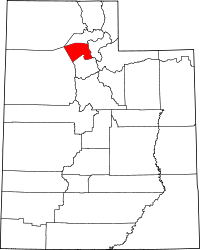Clinton, Utah
| Clinton, Utah | |
|---|---|
| City | |
|
Former Clinton City Hall | |
 Location in Davis County and the state of Utah | |
| Coordinates: 41°8′22″N 112°3′12″W / 41.13944°N 112.05333°WCoordinates: 41°8′22″N 112°3′12″W / 41.13944°N 112.05333°W | |
| Country | United States |
| State | Utah |
| County | Davis |
| Incorporated | 1936 |
| Area | |
| • Total | 5.8 sq mi (15.1 km2) |
| • Land | 5.8 sq mi (15.1 km2) |
| • Water | 0.0 sq mi (0.0 km2) |
| Elevation | 4,393 ft (1,339 m) |
| Population (2010) | |
| • Total | 20,426 |
| • Estimate (2014) | 21,104 |
| • Density | 3,609/sq mi (1,393.3/km2) |
| Time zone | Mountain (MST) (UTC-7) |
| • Summer (DST) | MDT (UTC-6) |
| ZIP code | 84015 |
| Area code(s) | 385, 801 |
| FIPS code | 49-14290[1] |
| GNIS feature ID | 1426725[2] |
| Website |
clintoncity |
Clinton is a city in Davis County, Utah, United States. It is part of the Ogden–Clearfield, Utah Metropolitan Statistical Area. The population was 20,426 at the 2010 census,[3] up from 12,585 at the 2000 census. Clinton grew rapidly during the 1990s and continues to see rapid growth, with an estimated population of 21,104 in 2014.[4]
Geography
Clinton is located in northern Davis County, bordered by Sunset to the east, Clearfield to the southeast, and West Point to the southwest. The northern border of Clinton is the Weber County line, with the city of Hooper to the northwest and Roy to the north and northeast. According to the United States Census Bureau, Clinton has a total area of 5.8 square miles (15.1 km2), all of it land.[3]
History
Dry farming began in the area of Clinton in 1879. By 1881 there was a railroad station. In 1884 the Summit Basin Branch of The Church of Jesus Christ of Latter-day Saints was organized in Clinton.[5]
A ward was organized in Clinton in May 1897, which was named Clinton.[6]
Demographics
| Historical population | |||
|---|---|---|---|
| Census | Pop. | %± | |
| 1900 | 247 | — | |
| 1910 | 611 | 147.4% | |
| 1920 | 846 | 38.5% | |
| 1930 | 795 | −6.0% | |
| 1940 | 581 | −26.9% | |
| 1950 | 670 | 15.3% | |
| 1960 | 1,025 | 53.0% | |
| 1970 | 1,768 | 72.5% | |
| 1980 | 5,777 | 226.8% | |
| 1990 | 7,945 | 37.5% | |
| 2000 | 12,585 | 58.4% | |
| 2010 | 20,426 | 62.3% | |
| Est. 2015 | 21,399 | [7] | 4.8% |
As of the census[1] of 2000, there were 12,585 people, 3,529 households, and 3,137 families residing in the city. The population density was 2,286.2 people per square mile (883.5/km²). There were 3,643 housing units at an average density of 661.8 per square mile (255.7/km²). The racial makeup of the city was 90.35% White, 1.01% African American, 0.63% Native American, 1.78% Asian, 0.31% Pacific Islander, 3.62% from other races, and 2.30% from two or more races. Hispanic or Latino of any race were 8.03% of the population.
There were 3,529 households out of which 58.7% had children under the age of 18 living with them, 78.3% were married couples living together, 7.4% had a female householder with no husband present, and 11.1% were non-families. 8.6% of all households were made up of individuals and 2.2% had someone living alone who was 65 years of age or older. The average household size was 3.55 and the average family size was 3.76.
In the city the population was spread out with 37.8% under the age of 18, 11.7% from 18 to 24, 31.8% from 25 to 44, 14.8% from 45 to 64, and 4.0% who were 65 years of age or older. The median age was 25 years. For every 100 females there were 101.9 males. For every 100 females age 18 and over, there were 99.3 males.
The median income for a household in the city was $53,909, and the median income for a family was $55,282. Males had a median income of $38,797 versus $22,350 for females. The per capita income for the city was $17,020. About 3.0% of families and 3.6% of the population were below the poverty line, including 5.5% of those under age 18 and 1.3% of those age 65 or over.
References
- 1 2 "American FactFinder". United States Census Bureau. Archived from the original on 2013-09-11. Retrieved 2008-01-31.
- ↑ "US Board on Geographic Names". United States Geological Survey. 2007-10-25. Retrieved 2008-01-31.
- 1 2 "Geographic Identifiers: 2010 Demographic Profile Data (G001): Clinton city, Utah". American Factfinder. U.S. Census Bureau. Retrieved January 11, 2016.
- ↑ "Annual Estimates of the Resident Population for Incorporated Places: April 1, 2010 to July 1, 2014". Retrieved June 4, 2015.
- ↑ Jenson, Andrew. Encyclopedic History of the Church of Jesus Christ of Latter-day Saints (Salt Lake City: Deseret News Press, 1941) p. 149
- ↑ Jenson. Encyclopedic History. p. 149
- ↑ "Annual Estimates of the Resident Population for Incorporated Places: April 1, 2010 to July 1, 2015". Retrieved July 2, 2016.
- ↑ "Census of Population and Housing". Census.gov. Archived from the original on May 11, 2015. Retrieved June 4, 2015.
External links
 |
Hooper | Roy |  | |
| Great Salt Lake | |
Sunset | ||
| ||||
| | ||||
| West Point | Clearfield |

